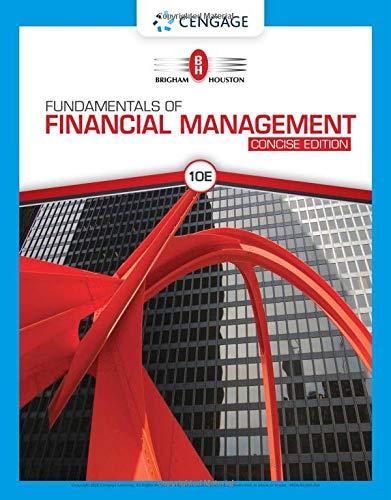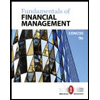
Concept explainers
a.
To determine: The cost of each of the capital components.
Introduction:
Cost of Capital:
In any company there is a need of fund for various purposes. The companies raise capital through various sources such as equity, debt, and
After-Tax Cost of Debt:
It can be defined as relevant cost of new debt considering tax deductibility in interest. It is the cost of debt after tax savings. The interest on the debt is tax deductible. The tax can be saved on the interest paid on the debt. It is used to calculate the weighted average cost of capital.
Cost of Preferred Stock:
The return earned by the firm’s preferred stockholders from the investment in preferred stock is a cost of the preferred stock. It is computed by dividing the dividend received on preferred stock by the current price of the preferred stock.
Cost of Equity:
It is the cost of the company while raising finance by issuing equity. It is the earnings from the investment to the firm’s equity investors. It is the return to the stockholders’ equity investments. The issue of new stock incurs the flotation cost.
b.
To determine: WACC of A Corporation.
Introduction:
Weighted Average Cost of Capital:
It is the weighted average cost of capital of all the sources through which a firm finances its capital. It is the rate that a company will pay to all for raising finance. It can be termed as firm’s cost of capital. The company raises money through various sources such as common stock and preference share debt. The WACC is computed by taking the relative weight of each item of capital structure.
c.
To identify: The projects that should be accepted by A Corporation. If only the project with expected returns more than WACC should be accepted.
Want to see the full answer?
Check out a sample textbook solution
Chapter 10 Solutions
Fundamentals of Financial Management, Concise Edition
- Take value of 1.01^-36=0.699 . step by steparrow_forwardsolve this question.Pat and Chris have identical interest-bearing bank accounts that pay them $15 interest per year. Pat leaves the $15 in the account each year, while Chris takes the $15 home to a jar and never spends any of it. After five years, who has more money?arrow_forwardWhat is corporate finance? explain all thingsarrow_forward
 EBK CONTEMPORARY FINANCIAL MANAGEMENTFinanceISBN:9781337514835Author:MOYERPublisher:CENGAGE LEARNING - CONSIGNMENT
EBK CONTEMPORARY FINANCIAL MANAGEMENTFinanceISBN:9781337514835Author:MOYERPublisher:CENGAGE LEARNING - CONSIGNMENT Intermediate Financial Management (MindTap Course...FinanceISBN:9781337395083Author:Eugene F. Brigham, Phillip R. DavesPublisher:Cengage Learning
Intermediate Financial Management (MindTap Course...FinanceISBN:9781337395083Author:Eugene F. Brigham, Phillip R. DavesPublisher:Cengage Learning Fundamentals Of Financial Management, Concise Edi...FinanceISBN:9781337902571Author:Eugene F. Brigham, Joel F. HoustonPublisher:Cengage Learning
Fundamentals Of Financial Management, Concise Edi...FinanceISBN:9781337902571Author:Eugene F. Brigham, Joel F. HoustonPublisher:Cengage Learning Fundamentals of Financial Management, Concise Edi...FinanceISBN:9781305635937Author:Eugene F. Brigham, Joel F. HoustonPublisher:Cengage Learning
Fundamentals of Financial Management, Concise Edi...FinanceISBN:9781305635937Author:Eugene F. Brigham, Joel F. HoustonPublisher:Cengage Learning




